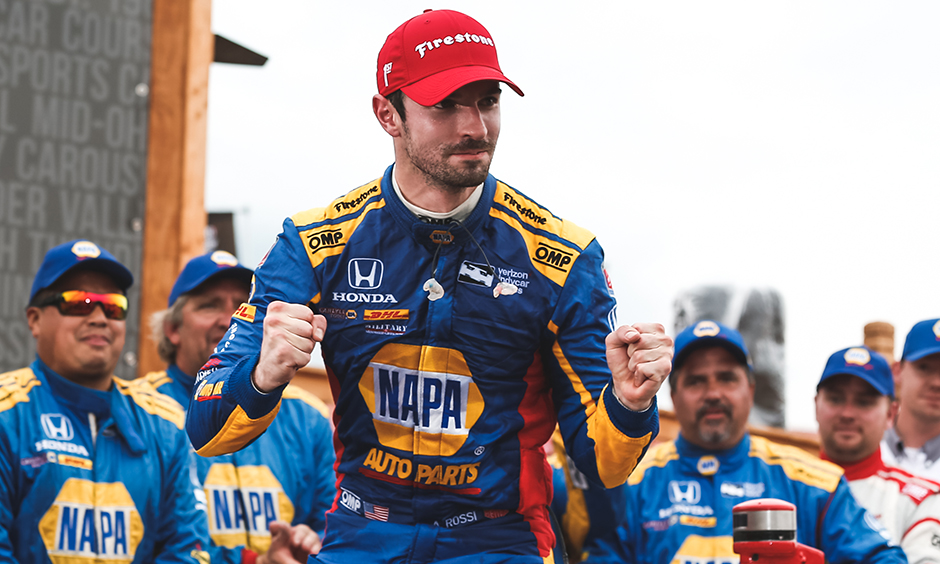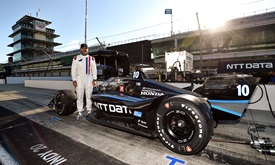Rear View Mirror: Rossi Reaped 2018 Mid-Ohio Win from Pressure-Filled Strategy Decisions
JUL 29, 2020
When an NTT INDYCAR SERIES team makes the bold decision to go against conventional pit strategy, it either works famously or fails dramatically.
For Alexander Rossi and his No. 27 Honda crew at Andretti Autosport, they used a two-stop strategy to perfection in a dominant victory in the 2018 Honda Indy 200 at Mid-Ohio Sports Car Course.
Rossi started on the pole, led 66 laps in the 90-lap contest and defeated Robert Wickens by a whopping 12.829 seconds.
RELATED: Classic Rewind: 2018 Mid-Ohio
2016 Indianapolis 500 presented by Gainbridge winner Rossi worked the two-stop strategy to perfection.
“It was a big debate for us because it really hadn’t been the way to go at all during years past at Mid-Ohio,” Rossi said. “Charlie Kimball won his race in 2013 on a three-stopper when everybody else tried to go with two.”
Rossi and his Andretti Autosport crew, however, realized with the evolving universal aero kit on the Dallara chassis in 2018, the fuel mileage improved dramatically since the days when the three-stop strategy was the path to victory at Mid-Ohio.
But would the improved aerodynamics and less aero drag on the Dallara, combined with improved fuel efficiency from the Honda engine, be enough to make it work at Mid-Ohio?
Rossi and Andretti Autosport decided to put it to a test in the Friday practice session that weekend.
“We took the time in that second practice on Friday to achieve a fuel number that seemed doable,” Rossi said. “We were only going to do it if we were able to get pole and then keep the lead through the first lap and control the pace from there.
“Fortunately, we were able to do that. Out front, it was pretty easy to do the lap time and save fuel. It all worked out for us. Most of the time, it’s a toss-up one day or another.
“If you are having a two-stopper, you are praying for no yellows, for sure.”
The key to the two-stop strategy and why they would only try it if Rossi won the pole is another example of aerodynamics.
A car out front gets clean air, which allows a driver to conserve fuel. Drivers trailing often burn extra fuel because their chasing and because their car must drive through turbulent “dirty” air from the car ahead.
“Not only do you burn fuel, but you use a lot more tires when you are behind a car,” Rossi said. “I started second to Will Power last year and was in that two-second range and had worse fuel mileage and tire deg (degradation) than he did.
“It’s 50 percent easier to dictate a two-stop strategy if you’re upfront and don’t have to deal with a car in front of you.”
To devise the strategy, a driver needs the utmost confidence in the calculations devised by his engineer and race strategist. In Rossi’s case, that’s engineer Jeremy Milless and race strategist Rob Edwards, the chief operating officer at Andretti Autosport.
“When you win the pole, you control your own destiny in terms of being able to control the pace of the race,” Edwards said. “It either works brilliantly, or you fall flat on your face.
“It worked for us in 2018 and worked for Scott Dixon last year in 2019, as well.”
According to Edwards, the differences between the two-stop and three-stop strategies are dramatic. It’s the difference between pushing the accelerator to the floor or feathering the pedal.
“The thing with the three-stopper is both have worked, but it depends on getting through traffic,” Edwards said. “To do a three-stopper, you are running hard, being able to run as hard as you can for as many laps as possible. That means you need a clean track.
“The two-stopper, you control the race, you control the pace, you are in clean air, so you are easier on the car and easier on the tires and you control your own destiny rather than relying on dealing with back markers.
“In 2018, Robert Wickens had a very quick car, but at some critical moments in the race, he got held up by some slower cars, and that kept him from mounting the challenge he might have normally mounted.”
Rossi has a complete understanding of what it takes on the racetrack and what he likes to get out of his No. 27 AutoNation/NAPA AUTO PARTS Honda. Milless deciphers the data and calculates the right setup to Rossi’s and the track’s needs.
Edwards stands on the top step of the pit stand and makes the decisions based on the flow and rhythm of the race.
There is a very narrow window of opportunity when the team must decide to stick with an unorthodox strategy or return to the conventional wisdom.
“You are leaning on them,” Rossi said. “You know how many laps you are trying to get to, and you know the fuel target, but they have to keep an eye on whether the pace is good enough to warrant continuing on that strategy. You can start on a two-stop strategy, but if you start losing too much time to these guys on a three-stopper with new tires that are going to go hard, you have to bail.
“There is a two- or three-lap period where you have to have enough pace to not lose track position or get caught with lapped cars. There is a lot that goes into consideration they are taking into account.
“It is such a team effort to win any INDYCAR race, let alone one where you win it on strategy.”
It’s also the ability to properly measure, calculate and predict risk versus reward.
On this particular day in 2018, the team minimized the risks, Rossi raced away from his competition, and the reward was huge with an impressive victory in the Honda Indy 200 at Mid-Ohio.



















